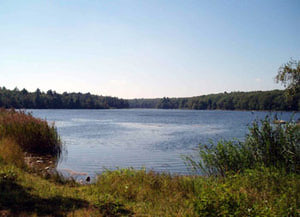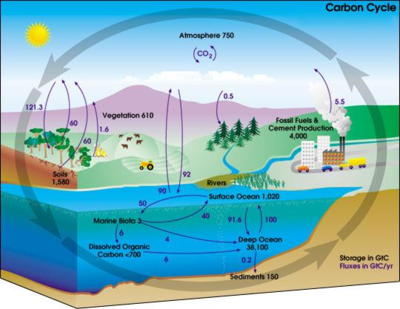Freshwater Lakes
Introduction
Freshwater lakes are bodies of still, unsalted water surrounded by land. They are usually found in low lying areas and are fed from streams, rivers and runoff from the surrounding area. Freshwater lakes provide a unique habitat for microbes because they differ from other aquatic habitats such as oceans and moving water. This habitat is home to a plethora of microbes such as Proteobacteria, Actinobacteria, Cyanobacteria, and Bacteroidetes. These microbes help sequester inorganic compounds, mineralize nitrogen, and decompose organic matter, as well as other important processes.
Physical environment
Physical
Freshwater lakes are formed in a variety of different ways and depending on how a lake was formed, it can affect the microbes that are able to live and survive. Common types of lakes are stream or river fed lakes, glacial lakes, which are created by melting glaciers, and artificial lakes, which can be formed by the addition of a dam from old mines or quarries which have filled in after use. Another more unique lake type is a subglacial lake, which is a lake permanently covered by ice such as in Antarctica. In addition to the formation affecting microbial composition, lake stratification can make a difference throughout a lake.
Stratification
Environmental factors such as pH, dissolved oxygen, nutrient concentrations, and light availability are affected by lake stratification. Thermal differences are what cause a lake to stratify into a warm upper layer, the epilimnion, a lower cool layer, the thermocline, and the deepest coldest layer, the hypolimnion, due to cooler water having a higher density than warm water. These differences cause completely different habitats to exist throughout a lake. The epilimnion has the highest dissolved oxygen, and light availability, but is low on nutrients. Aerobic microbes are most abundant here. The thermocline has less oxygen and light, but more nutrients creating a habitat for facilitative anaerobes. The cold hypolimnion contains almost no oxygen or light, however, it contains abundant nutrients. Anaerobes thrive in these conditions, but because of their metabolisms, they are unable to take full advantage of the nutrients (Ndebele 2010).
River Fed
These lakes have their input and output from rivers. This differs then from other types of lakes because they can receive storm water run off from not only the surrounding area but from all the areas in the basin of the lake and feeding rivers.
Subglacial
A subglacial lake is one in which there is flowing water under a glacier, ice cap, or ice sheet. They are found is regions such as Antarctica which are constantly under the freezing point. Only certain types of unique bacteria are able to thrive in such environments. This is also the only type of lake which is known to exist in an extraterrestrial location. Jupiter’s moon Europa’s surface is entirely covered in an ice sheet, and it is believed to be one of the most likely locations for extraterrestrial life.
Artificial
These include lakes formed from dams,man-dug, or mines and quarries.
Dammed
Dammed lakes are fed by rainwater and inflow of a river, and drain from outflow from drains on the dam. Water quality testing is done often in this type of lake to insure the dam or other inputs are not polluting the water.
Man-made
These lakes only receive water run off from the surrounding areas and precipitation. Lakes such as these are often built near roadways and other urban areas and have a higher about of pollutants than more natural lakes.
Mines/Quarries
Old and abandoned mines and quarries often become lakes because most require the use of water control devices to keep ground water from seeping in. Lakes formed this way often have high amounts of contamination due to chemicals and machinery used in the harvesting process.
Chemical
Many factors contribute to the chemical environment in which lake microbes live. These include the drainage basin, the amount of water flowing in and out of a lake, the concentrations of nutrients and dissolved oxygen, the pH, and any pollutants and sedimentation in a lake. The overall drainage basin will affect the amount of run off from other sources in the surrounding area, which will, in turn, affect the amount of nutrients available to microbes and will increase pollutants and sedimentation. The lake level, which is regulated by inflow and outflow of a lake, the pH and the dissolved oxygen content in a lake, will also determine what types of microbes can survive because each microbe has its own unique environmental conditions in which it can outcompete the competition (Paul 2008).
Stratified Lakes
Lake stratification also has an affect on chemical characteristics, and the redox reactions microbes are able to perform. In the epilimnion, the abundant oxygen and light allow for anaerobes to use oxygen as their terminal electron acceptor. Aerobic respiration is capable of producing the most amount energy. The thermocline and hypolimnion, have less oxygen and are forced to use anaerobic respiration when lacking oxygen. This includes reduction of sulfur and iron by microbes and does not produce a lot of energy.
Microbial communities
The microbial community in freshwater lakes is as diverse as any other ecosystem found on earth. These microbes have found a way to take advantage of the different resources provided from lake habitats oppose to terrestrial soil habitats microbes are usually thought to live. The main players are Proteobacteria, Cyanobacteria, Actinobacteria, and Bacteroidestes. All of these different microbes contribute to important processes carried out in freshwater lakes.
Proteobacteria
This is the most abundant and commonly found group of microbes in freshwater lakes. Taxa include Rickettsia prowazekii, Coxiella burnetti, and Wolinella succinogenes. Proteobacteria is broken up into alpha-, beta-, delta-, and gammaproteobacteria, each with their own distinct characteristics (Yannarell 2009).
Alpha/Gammaproteobacteria
Alphaproteobacteria and Gammaproteobacteria are mostly commonly found in marine habitats, but still can be found in freshwater water columns. They tend to be phototrophic and contribute to increasing the amount of dissolved oxygen in a lake. Taxa include Acetobacter and Acinetobacter for Alphaproteobacteria and Gammaproteobacteria respectively.
Betaproteobacteria
Betaproteobacteria are most common of the proteobacteria in lakes. They consist of Chemolithotrophes and phototrophs, who in some places makes up 60% of the bacterioplankton. They also play an important role in nitrogen fixation and oxidation of ammonium (Wetzel 2000). Taxa include Alcaligenes and Nitrosomonas
Deltaproteobacteria
Deltaproteobacteria tend to live in anaerobic conditions such as the bottom of lakes or in sediment and they commonly reduce sulfur as a source of energy. Taxa include Desulfovibrio and Geobacter.
Cyanobacteria
Cyanobacteria are other bacteria which preforms photosynthesis. They tend to be the dominant bacterial phototrophs in open parts of a lake and are important in the carbon cycle, but also the nitrogen cycle because some are capable of nitrogen fixation.
Actinobacteria
This microbe can be found in a wide range of aquatic conditions. They are decomposers of organic matter and tend to favor conditions with low concentrations of organic carbon because they can be outcompeted when carbon concentration rise.
Bacteroidetes
This microbe is a commonly particle associated in bacterial communities. They are found at the bottom of lakes where they can degrade larger molecules.
Microbial processes
The two main microbial processes that occur in freshwater lake habitats are the nitrogen and carbon cycle. Both these cycles affect the lives of the macro flora and fauna which share this habitat.
Carbon cycle
The carbon cycle allows carbon to be recycled and reused throughout the biospheres and all living organisms. It is essential for new life. Bacteria help breakdown dead and decaying organic matter. During decomposition, these bacteria will release carbon dioxide if oxygen is present, or methane if it is not. While this diagram (fig. 1) shows the carbon cycle in marine habitats, the same is true in freshwater lakes but at a much smaller scale.
Nitrogen cycle
The Nitrogen cycle (fig. 2) is the process in which nitrogen is converted into different forms. The majority of nitrogen is found in the atmosphere where it is unusable by plants, but through the processes of microbes, such as nitrification and denitrification, it can be converted into a form plants can consume. Nitrification is performed by Nitrospira is the oxidation of ammonia into nitrate. Denitrification is performed by Flexibacter converts nitrate in to nitrogen gas. It is important to note that Nitrospira is a type of Betaproteobacteria, and Flexibacter is a type of Bacteroidetes (Krivtsov 2005).
Other processes
Another important process that is carried out in freshwater habitats is decomposition. Decomposition is the breaking down of organic matter into simpler forms. This is preformed by different types of microbes such as actinobacteria and results in the reduction of dead organic matter in the lake, and increased food sources for living flora and fauna. Without decomposition, lakes would be clouded with a layer of dead organic matter and there would be very little sunlight penetration for photosynthesis. Anaerobic respiration is one more important process that occurs in stratified freshwater lakes. This includes the reduction of iron, manganese, and sulfur, all which can affect the bio-availability of these micronutrients (Nealson 1994).
Current Research
Koschorreck et al.
In a study done in 2011 by Koschorreck et al., They looked at how adding whey to an acidic mine pit lake could induce oxygen depletion. They added whey into the water column or the lake and mixed it using a boat motor. By doing this they found it helped neutralize the acidity of the pit and allowed oxygen consumption. This allowed for a wider variety of biota, including microbes, to inhabitant these zones. Even though a small amount of oxygen was produced by primary producers, this still led to anoxic conditions.
Verleyen et al.
This study done in 2012 looked at polar lakes and how they responded to climate induced environmental changes. They looked at differences in pH, and concentrations of major nutrients between lakes. They found the variability could have been caused by lake origin and evolution, catchment areas, distance of lakes to ice sheets and presence of particular biota.
Esteban et al
This study done in 2012 looked at water columns of Priest Pot. It is a highly stratified lake and they found that dissolved oxygen content at changing depths was the main factor that determined which microbes lived where. Different microbes can utilize different niches because microbes do not all have the same enzymes and microbes can metabolize different substrates. They also looked at biological activity driven my microbes, and looked at the different species present throughout the water column and sediments.
References
Esteban, G., Finlay,B., and Clarke, K. 2012. "Priest Pot in the English Lake District: a showcase of microbial diversity". Freshwater Biology. 57: 321-330.
Koschorreck, M., Boehrer, B., Frieses, K., et al. 2011. "Oxygen depletion induced by adding whey to an enclosure in an acidic mine pit lake". Ecological Engineering. 37: 1983-89.
Krisvtsov, V., Sigee, D. 2005. "Importance of biological and adiotic factors for geochemical cycling in a freshwater eutrophic lake". Biogeochemistry. 74: 205-30.
Lindstrom, E., Agterveld, M., and Zwart, G. 2005. "Distribution of Typical Freshwater Bacterial Groups Is Associated with pH, Temperature, and Lake Water Retention Time". American Society for Microbiology. 71: 8201-06.
Ndebele, M., Mzime, R., Musil, C., Charles, F., et al. 2010. "A review of Phytoplankton dynamics in tropical African lakes". South African Journal of Science. 106: 13-18.
Nealson, K., Saffarini, D. 1994. "Iron and Manganese in Anaerobic Respiration: Environmental Significance, Physiology, and Regulation". Annual Review of Microbiology. 48: 311-43.
Paul, D., Hebert, N. 2008. "Chemical properties of lakes". Encyclopedia of Earth.
Verleyen, E., Hodgson, D., Gibson,J., Imura, S., et al. 2012. "Chemical limnology in coastal East Antarctic lakes: monitoring future climate change in centres of endemism and biodiversity" Antarcitic Science. 24: 23-33.
Wetzel, R. 2000. "Freshwater ecology: changes, requirements, and future demands". Limnology, 1: 3-9.
Yannarell, A., Kent, A. 2009. "Bacteria, Distribution and community Structure". University of Illinois at Urbana-Champaign.
Edited by Neal Phelps, a student of Angela Kent at the University of Illinois at Urbana-Champaign.



